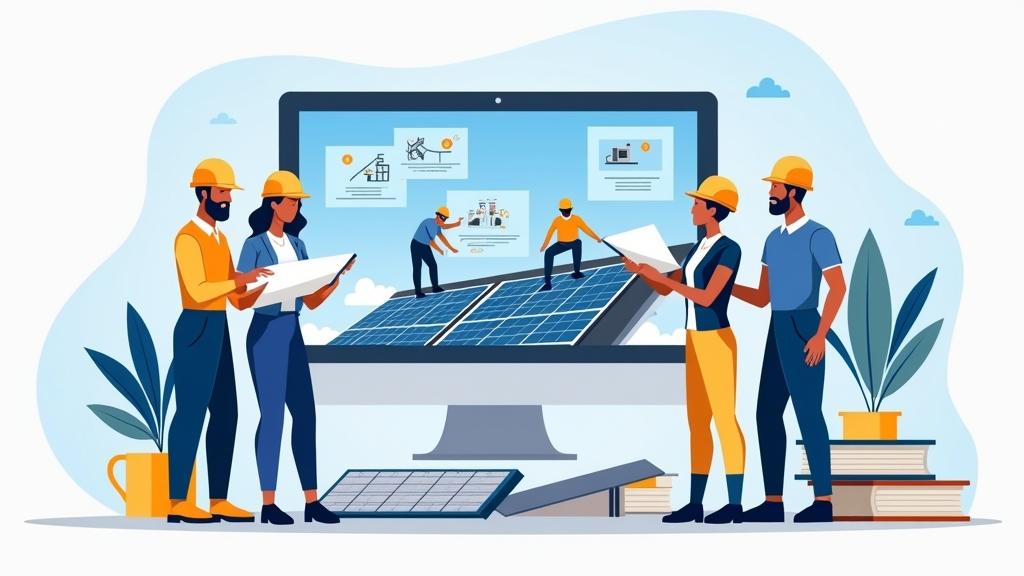advertising
Imagine being able to turn sunlight into clean, renewable electricity, reducing energy bills and helping the planet at the same time. That's exactly what photovoltaic solar energy offers, and this sector is growing exponentially all over the world.
With the global demand for sustainable energy sources, the profession of solar panel installer has become one of today's most promising technical careers. Those who master this skill not only acquire a valuable trade, but also position themselves at the forefront of the energy transition. So if you're looking for a profession with purpose, stability and growth potential, read on and find out how to enter this fascinating field.
advertising
Every day, more homes, companies and industries are opting to install solar systems, creating a hot market full of opportunities. Have you ever thought about what it would be like to be able to work outdoors, solve technical problems and see the tangible result of your work on a customer's roof? This reality is within reach for anyone looking for the right qualification. The good news is that there are accessible paths, including free options, for you to get trained and start working in this market. Let's explore together everything you need to know to become a qualified professional.
Fundamentals of Photovoltaic Solar Energy
Before you get your hands dirty and get on the roof, it's essential to understand the basic principles that govern the technology. What is a solar panel, anyway, and how is sunlight transformed into usable energy for your TV or fridge? It all starts with photovoltaic effectPhotovoltaics is a physical phenomenon where semiconductor materials, such as silicon, convert solar radiation directly into direct current electricity. Each panel is made up of several interconnected photovoltaic cells, and the energy they generate is just the first step in a more complex and intelligent process.
Understanding the difference between on-grid and off-grid systems is crucial for any installer. In an on-grid system, the surplus energy produced during the day is injected into the public electricity grid, acting as a credit for the consumer to use at night or on cloudy days. Off-grid systems, on the other hand, which are more common in remote locations, rely on batteries to store the energy, ensuring a continuous supply. Can you see how knowledge of these two configurations determines the planning and execution of a project?
In addition, concepts such as solar irradiance, tilt angle and panel orientation (generally north in the southern hemisphere and south in the northern hemisphere) are pillars for maximizing system efficiency. A online course A quality manual dedicated to technical fundamentals will cover these topics in detail, providing you with the solid foundation you need to not only carry out installations, but also plan them in the best possible way. Remember: a good professional not only installs, but also understands the science behind each component.
System Components and Their Functions
A solar energy system is like an orchestra, where each instrument has a specific function and all need to be in perfect harmony for the concert to go well. The most visible component is undoubtedly the photovoltaic modulessolar panels, popularly known as solar panels. They are responsible for capturing sunlight and generating energy. But on their own, they can't power the appliances in your home. The energy they produce is Direct Current (DC), and most of our household appliances run on Alternating Current (AC).
That's where inverterIt is the brains of the system. This vital piece of equipment converts DC to AC, monitors performance and guarantees the safety of the installation. Imagine the inverter as a translator that allows the energy from the panels to "talk" perfectly with the electricity grid in your home and with all your equipment. Choosing the right inverter, considering power, efficiency and technical characteristics, is one of the most important decisions in a project.
For off-grid or hybrid systems, the batteries are equally essential components, acting as energy reservoirs. And we mustn't forget the fixing structures, which ensure that the panels remain secure and firm on the roof or ground, resisting the weather for decades. An in-depth knowledge of each of these parts, their brands, specifications and how they interconnect is what separates an amateur from an excellent professional. How about opening the website of a major manufacturer to familiarize yourself with the models available? One suggestion is to visit the Solar Beast to see real examples of components.
The Step-by-Step Guide to Safe and Efficient Installation

Now that we know the theory and the components, it's time to get down to business. The installation itself is a meticulous process that requires attention to detail and, above all, safety. It all starts with a correct sizingThis is the precise calculation of the number of panels and inverter power needed to supply the site's energy consumption. Poor sizing can lead to a system that is oversized, generating unnecessary costs, or undersized, which will not meet the client's expectations.
With the project in hand, the practical stage begins with the assembly of the support structure on the roof, followed by the fixing of the panels. The wiring and connection of the modules in strings (series assemblies) must be carried out with extreme care, using the specific connectors and cables for the photovoltaic application. The installation of the inverter and the protection system, including circuit breakers and surge protection devices, is the step that guarantees safe integration with the existing power grid. Can you imagine the satisfaction of seeing all the panels positioned and connected, ready to start generating energy?
The final phase involves commissioning and testing. After all the connections have been made, the system is switched on and its operation is checked. It is crucial to test the voltage, current and generation of each string, ensuring that everything is operating within the expected parameters. Many installers use specific software and applications to monitor the system's performance in real time. Remember: your signature will attest to the quality and safety of the work, so nothing can be left to chance. To learn more about technical standards, you can consult the Official Gazette of your country to access local regulations.
Pathways to Qualification: Free and Paid Courses
You may be asking yourself: "How can I acquire all this knowledge in an accessible way?" Fortunately, the path to training is more democratized than ever. There are educational institutions, governments and non-governmental organizations that offer free solar installation courses as a way of fostering skilled labor and promoting clean energy. These courses often cover everything from the basics to installation practices, making them a fantastic entry point for those just starting out.
In addition to free options, the market offers a diverse range of paid courses, which usually provide greater depth, complete teaching material, recognized certification and, in many cases, internships or contact opportunities with companies in the sector. Distance learning platforms are an excellent alternative for those looking for flexible hours, allowing you to study without having to leave your current job. Investing in a good online course can be the key to accelerating your career and standing out in the market.
How can you find these opportunities? Keep an eye on employment and professional qualification portals, city and state government websites, as well as federal education institutes. Searching the internet for terms such as "free solar energy course" or "photovoltaic training" can reveal valuable options. A practical tip is to register on the Solar Workforce Allianceis an international organization that frequently advertises training programs around the globe. Take advantage of these opportunities to build your future.
Certification and integration into the job market
Finishing a course is a big step, but what do you do next to actually enter the profession? A professional certification is a competitive advantage and, in some regions, a legal requirement for signing off on projects and carrying out installations. It formally certifies your skills to the market and your clients, conveying trust and credibility. Think of certification as your passport to bigger and better-paid projects.
With your knowledge and certification in hand, it's time to look for a job. You can choose to work as an employee of a company specializing in solar energy, where you will have the opportunity to learn from experienced professionals and take part in various projects. Another path, quite common in this area, is to become an entrepreneur and open your own installation business. Demand is so high that many installers start out as self-employed and soon need to build up a team to handle all the services. Can you imagine owning your own time and building a respected brand?
Building a portfolio, even if initially with small installations for family and friends, is a smart strategy for demonstrating your ability. Use professional social networks, such as LinkedIn, to connect with other professionals in the sector, materials stores and potential clients. Don't underestimate the power of networking. Attend industry fairs and online events to keep up to date with the latest technologies and trends. To explore job vacancies, you can start by visiting global platforms such as LinkedIn Jobs. The market is hungry for good professionals - show that you are one of them.



